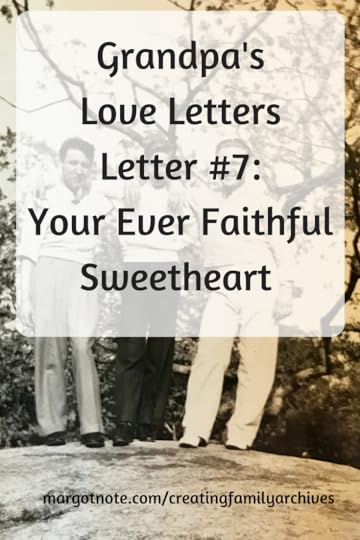Margot Note's Blog, page 43
February 20, 2018
Letter #13: 72 Hours To Go
I'm continuing my series of scanning, transcribing, and annotating my grandfather's love letters to my grandmother leading up to their marriage in June 1940. The letters are chronologically organized and preserved, using the methods I discuss in detail in my book, Creating Family Archives: How to Preserve Your Papers and Photographs.
In the 13th letter in the Grandpa's Love Letters series, Grandpa has changed boarding houses. He refers to the "three of us," which I think refers to himself, Otto, and Fred (Otto's cousin). This is another letter about when he'll be returning to Paterson, which depends on the weather.
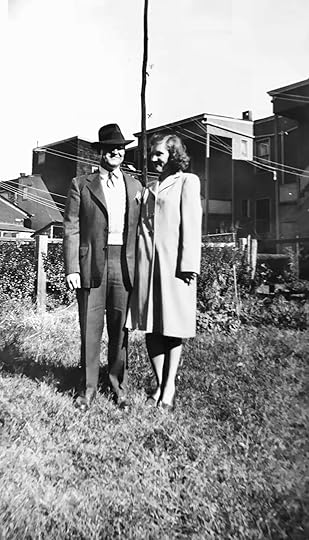
Ray and Ann in an undated photograph
I found this photograph, which dates (I'm assuming) from after my grandparents were married. It looks like they are posed in the backyard in Paterson, NJ. Even though their faces are heavily shadowed, I like that they are both smiling. Grandma is turned towards Grandpa and looking at him, while he looks at the camera.
They are in the same location of the photograph in this post, and the photograph seems to have been taken on the same day. Look how different the body language seems to be between both photographs!
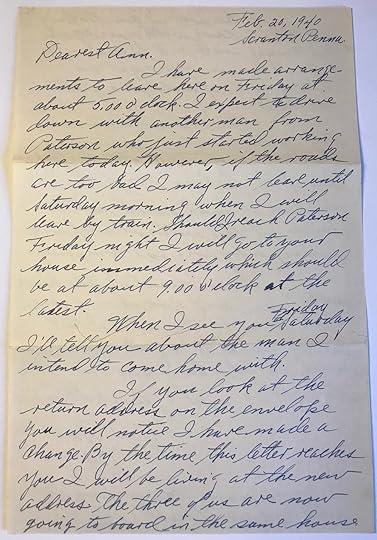
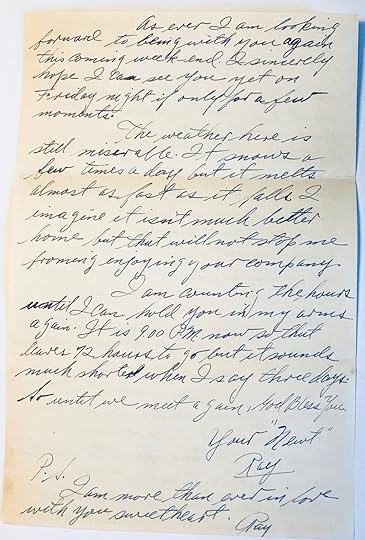
***
Feb. 20, 1940
Scranton Penna.
Dearest Ann,
I have made arrangements to leave here on Friday at about 5.00 clock. I expect to drive down with another man from Paterson who just started working here today. However, if the roads are too bad I may not leave until Saturday morning when I will leave by train. Should I reach Paterson Friday night I will go to your house immediately which should be at about 9.00 at the latest.
When I see you Friday or Saturday I'll tell you about the man I intend to come home with.
If you look at the return address on the envelope you will notice I have made a change. By the time this letter reaches you I will be living at the new address. The three of us are now going to board in the same house.
As ever I am looking forward to being with you again this coming week-end. I sincerely hope I can see you yet on Friday night if only for a few moments.
The weather here is still miserable. It snows a few times a day but it melts almost as fast as it falls. I imagine it isn't much better home but that will not stop me froming [sic] enjoying your company.
I am counting the hours until I can hold you in my arms again. It is 9.00 PM now so that leaves 72 hours to go but it sounds much shorter when I say three days. So until we meet again, God Bless you.
Your "Newt:"
Ray
P.S. I am more than ever in love with you sweetheart. Ray.
***
To learn the preservation secrets used by libraries, archives, and museums to protect their priceless materials (that you can also use for your family heritage items), read my book:
Creating Family Archives: How to Preserve Your Papers and Photographs
By Margot Note
If you like archives, memory, and legacy as much as I do, you might consider signing up for my email list. Every few weeks I send out a newsletter with new articles and exclusive content for readers. It’s basically my way of keeping in touch with you and letting you know what’s going on. Your information is protected and I never spam.
Ready to get started creating your family archives? Here are some of my favorite products:
Follow me on Pinterest | Instagram | Twitter | LinkedIn | Facebook
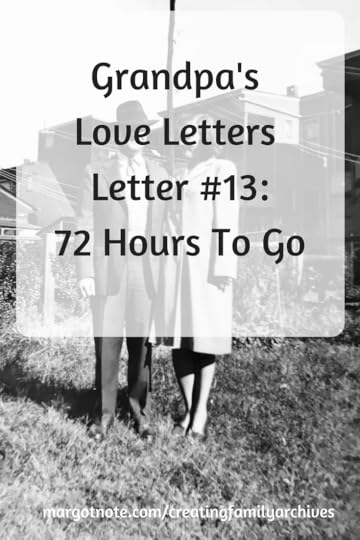
February 19, 2018
How to Identify and Date Photographs
In your collections, you will often come across photographs in a format that you cannot identify. These are primarily early photographs. By understanding the type of photograph you have, you can begin to learn when or why it was taken. Knowing the format is also helpful in finding out the best way to preserve the images.
Photo formats changed depending on the technology and trends of the time. By looking at some common characteristics of types of photographs, you can determine its format and figure out a range of years that the photograph was taken.
Ask yourself the following questions to discover what type of historical photograph you have:
Is the image shiny like a mirror? Can you only see image from an angle? It's a daguerreotype. (Lucky you, these are beautiful and the first photographic format!)Is image on a glass plate? Does image seem to have a slight depth? It's an ambrotype.Is image on a blackened metal plate? Will a magnet attach to it? It's a tintype.Is image on a thin card about 2 3/8" x 4"? It's a carte de visite.Is image mounted on a card 4 1/4" x 6 1/2"? It's a cabinet card.Most family collections contain cartes de viste and cabinet cards.
I've created a chart that lists photographic names, date ranges of popularity, and features to help you identify your formats. Download my Quick Guide to Common Types of Photographs and Images.
To learn the preservation secrets used by libraries, archives, and museums to protect their priceless materials (that you can also use for your family heritage items) read my book:
Creating Family Archives: How to Preserve Your Papers and Photographs
By Margot Note
Ready to get started creating your family archives? Here are some of my favorite products:
If you like archives, memory, and legacy as much as I do, you might consider signing up for my email list. Every few weeks I send out a newsletter with new articles and exclusive content for readers. It’s basically my way of keeping in touch with you and letting you know what’s going on. Your information is protected and I never spam.
Follow me on Pinterest | Instagram | Twitter | LinkedIn | Facebook
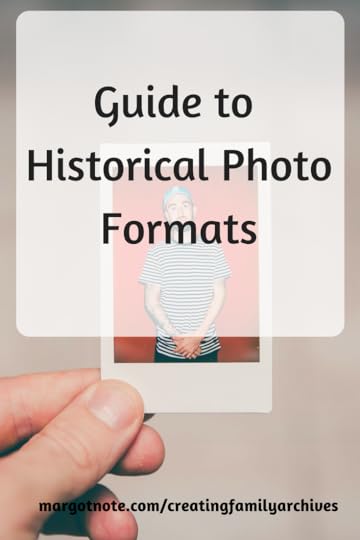

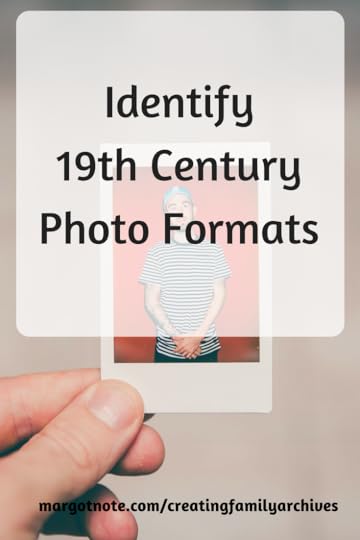
February 15, 2018
Letter #12: Valentine's Day Blizzard of 1940
I'm continuing my series of scanning, transcribing, and annotating my grandfather's love letters to my grandmother leading up to their marriage in June 1940. The letters are chronologically organized and preserved, using the methods I discuss in detail in my book, Creating Family Archives: How to Preserve Your Papers and Photographs.
The 12th letter in the Grandpa's Love Letters series is all about a major snowstorm in the area. The Valentine's Day Blizzard of 1940 hit the east coast by surprise. New England, New York, and Pennsylvania. It was one of the most memorable snowstorms on record in Boston because of the heavy snows and high winds.
Here's a link to newspaper photos of Scranton during the storm.
I've also found a photograph of Grandpa after a snowfall the next year, which looks significantly less than the blizzard!
[image error]
My grandmother wrote on the back of this photograph, "Ray Scranton, Pa 1941."
We also learn that Fred is Otto's cousin and doesn't like it in Scranton. In an earlier letter, he didn't seem to like the boarding rooms, but eventually got one.
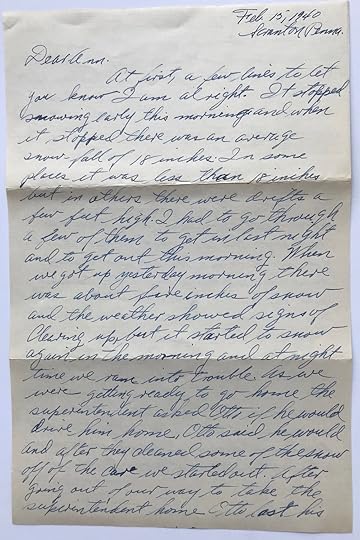

***
Feb. 15, 1940
Scranton Penna.
Dear Ann
At first, a few lines to let you know I am alright. It stopped snowing early this morning and when it stopped there was an average snow-fall of 18 inches. In some places it was less than 18 inches but in others there were drifts a few feet high. I had to go through a few of them to get in the last night and to get out this morning. When we got up yesterday morning there was about five inches of snow and the weather showed signs of clearing up, but it started to snow again in the morning and at night time we ran into trouble. As we were getting ready to go home the superintendent asked Otto if he would drive him home. Otto said he would and after they cleaned some of the snow off of the car we started out. After going out of our way ot take the superintendent home Otto lost his bearings for a few minutes in the blinding snow-storm. As a result we ended up downtown were [sic] we stopped to eat. We then started for home and got as far as the garage where we were stuck for an hour and a half. We had very little trouble getting to work this morning but had to wait long for connections to get home to-night.
Someone here called up the Paterson Mill this morning and heard that everything was tied up there too. Tell me what happened when you write to me. We are not coming home this weekend but Otto's cousin, Fred, is. He does not like it here at all and the snow-storm is making it all the worse.
It is to [sic[ bad it had to snow after we had gotten some hope of being to-gether again this weekend. There isn't very much we can do now, but hope for the best next weekend. It is 11.20 now, so I will close now and go to bed to dream sweet dreams of you. I really mean it, I often dream of you. I remain
Your Sweetheart
"Newt"
P.S. I love you more and more each day.
.***
To learn the preservation secrets used by libraries, archives, and museums to protect their priceless materials (that you can also use for your family heritage items), read my book:
Creating Family Archives: How to Preserve Your Papers and Photographs
By Margot Note
If you like archives, memory, and legacy as much as I do, you might consider signing up for my email list. Every few weeks I send out a newsletter with new articles and exclusive content for readers. It’s basically my way of keeping in touch with you and letting you know what’s going on. Your information is protected and I never spam.
Ready to get started creating your family archives? Here are some of my favorite products:
Follow me on Pinterest | Instagram | Twitter | LinkedIn | Facebook

February 13, 2018
Letter #11: Valentine's Day
I'm continuing my series of scanning, transcribing, and annotating my grandfather's love letters to my grandmother leading up to their marriage in June 1940. The letters are chronologically organized and preserved, using the methods I discuss in detail in my book, Creating Family Archives: How to Preserve Your Papers and Photographs.
In the 11th letter in the series, Grandma and Grandpa celebrate Valentine's Day. He sent flowers, and she sent a card, probably similar in style to this one.
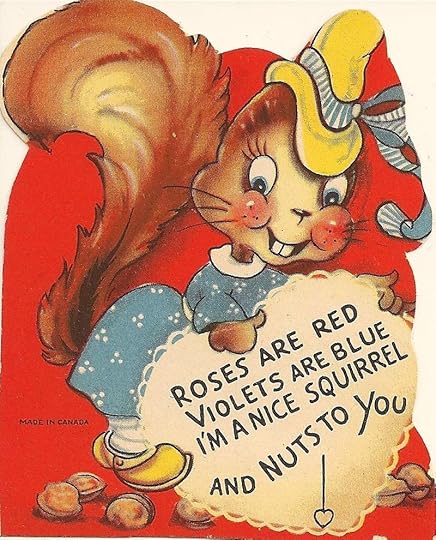
A typical 1940s era Valentine's Day card, courtesy Wikimedia Commons
Grandpa mentions a connection between the Scranton plant and the Paterson one, which makes me want to research what company employed him. Looks like Fred has his work cut out for him with designing! I'm assuming that he was a pattern-maker. My grandfather seems to be managing the inventory.
When I was organizing and archiving these letters, I unfolded them and laid them flat between pieces of acid-free cardboard. I placed books on top of the pile to gently allow them to lay flat. This letter seems to resist being flat, so I just let it do its thing as I photographed it!
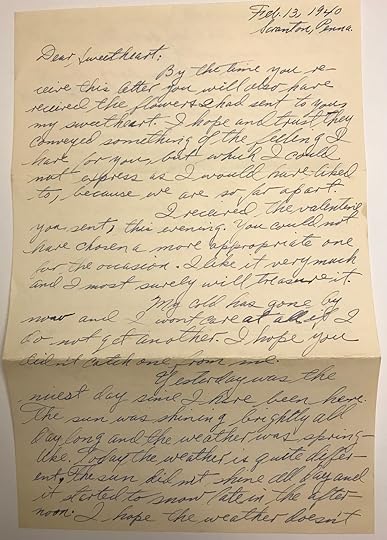
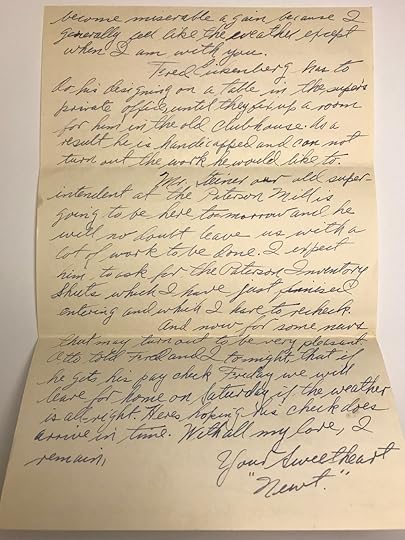
***
Feb 13, 1940
Scranton, Penna.
Dear Sweetheart:
By the time you receive this letter you will also have received the flowers I had sent to you, my sweetheart. I hope and trust they conveyed something of the feeling I have for you, but which I could not express as I would have liked to, because we are so far apart.
I received the valentine you sent, this evening. You could not have chosen a more appropriate one for the occasion. I like it very much and I most surely will treasure it.
My cold has gone by now and I won't care at all if I do not get another. I hope you didn't catch one from me.
Yesterday was the nicest day since I have been here. The sun was shining brightly all day long and the weather was spring-like. Today the weather is quite different. The sun did not shine all day and it started to snow late in the afternoon. I hope the weather doesn't become miserable again because I generally feel like the weather except when I am with you.
Fred Eickenberg has to do his designing on a table in the super's private office, until they fix up a room for him in the old clubhouse. As a result he is handicapped and can not turn out the work he would like to.
Mr. Steiner our old superintendent at the Paterson Mill is going to be here tomorrow and he will no doubt leave us with a lot of work to be done. I expect him to ask for the Paterson Inventory Shuts which I have just finished entering and which I have to recheck.
And now for some news that may turn out to be very pleasant. Otto told Fred and I tonight that if he gets his pay check Friday we will leave for home on Saturday if the weather is all-right. Here's hoping his check does arrive in time. With all my love, I remain,
Your Sweetheart
"Newt."
.***
To learn the preservation secrets used by libraries, archives, and museums to protect their priceless materials (that you can also use for your family heritage items), read my book:
Creating Family Archives: How to Preserve Your Papers and Photographs
By Margot Note
If you like archives, memory, and legacy as much as I do, you might consider signing up for my email list. Every few weeks I send out a newsletter with new articles and exclusive content for readers. It’s basically my way of keeping in touch with you and letting you know what’s going on. Your information is protected and I never spam.
Ready to get started creating your family archives? Here are some of my favorite products:
Follow me on Pinterest | Instagram | Twitter | LinkedIn | Facebook
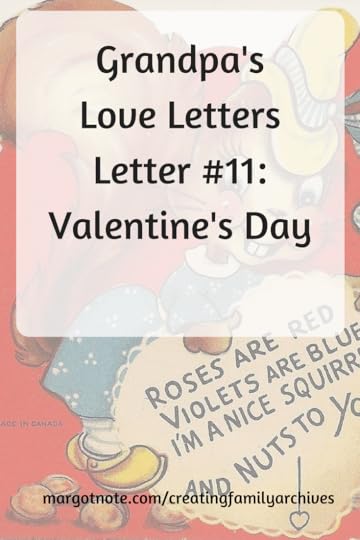
February 12, 2018
How to Take Notes as You Read
When you are researching for a paper, you should take notes, not only to retain the information you are seeking but also to guide the next steps in your research strategy. I advise my students to take notes, either by putting pen to paper or by using programs like Mendeley which allow you to mark and save articles. Reading for research is never passive; it should be an active exchange in which you respond to and interrogate the text. Here are some suggestions for taking notes as you read:
If the text will be discussed in class, come to class prepared. You'll take better notes and learn more if you've done the assigned reading or other work before the lecture. (And don't think your professor doesn't know that you haven't done the work. Oh, we know!)Choose the best medium for taking notes--by hand or by laptop. It will depend on your own preference and the content of the course. Choose the option that's most comfortable to you. When in doubt, go by hand. There's something about handwriting notes that helps you process them in your brain better. Begin actively reading by previewing a work to get a general idea of what to look for later when you read it more carefully. Examine the title and the abstract, if it's available. Look at the section titles, paragraphing, and other stylistic and structural features. Skim the footnotes. Pay attention to key concepts, considering the relationships between ideas, noting transitions, and thinking about how the material fits into the course as a whole. Mark the text. Underline important points, including the thesis and topic sentences. Circle words, phrases, or ideas that you would like to think more about. Draw lines between related words and ideas. Number incidents that occur in sequence. Note unfamiliar concepts and words. Look up words. Write their definitions in the margins, or create a working vocabulary list. Put question marks beside confusing passages and unfamiliar references. Talk back to the text. What questions do you want answered? What disagreements do you have with the author's arguments?Note cross-references to other materials you have read on the subject. How have their points agreed or disagreed with what you are reading now?Write summaries of the text to ensure that you have understood the material. Paraphrase as best you can. Copy statements that you might want to quote directly in your work. Use quotations marks to ensure that you know this is a quote (so you do not inadvertently plagiarize the passage). Note the complete bibliographic information for the quote.Create a working bibliography of all the sources you read for a project. Note URLs of the websites you visit, as well as the dates that you accessed them because websites can sometimes disappear. Keep a journal, either in a notebook or on your computer, to record the ideas and questions that occur to you as you read. In your journal, expand your marginal annotations, record your responses to works you have read, note questions, and explore emerging ideas. Keep things neat so when you refer to your notes later, you will not be confused.What tips do you use when reading and taking notes? I'd love to hear them. Share your suggestions in the comment section.
Follow me on Pinterest | Instagram | Twitter | LinkedIn |
Like this post? Never miss an update when you sign up for my newsletter:

February 11, 2018
Letter #10: How Proud I Felt
I'm continuing my series of scanning, transcribing, and annotating my grandfather's love letters to my grandmother leading up to their marriage in June 1940. The letters are chronologically organized and preserved, using the methods I discuss in detail in my book, Creating Family Archives: How to Preserve Your Papers and Photographs.
I can't believe we're already at the 10th letter so far! In this letter, Grandpa returns home from a weekend in Paterson, NJ. He originally was going to return on Monday, but came home on Sunday instead. His friend Fred (I'm assuming from the neighborhood) has come to Scranton to work in the factory too.
I'm curious about what rooms in boarding houses looked like. There are so few of these types of buildings around anymore. I remember visiting one near the campus of the University of Minnesota and one in Brooklyn years ago. I can't imagine sharing a bathroom with strangers, but I can imagine that in time you figure out a way to make it work.
I found this picture of my grandparents dolled up and happy from 1941. They would've been just married. Is Grandma wearing the coat and dress that Grandpa talked about in the letter? Were they on their way to church? Who's taking the picture? Is it Otto?
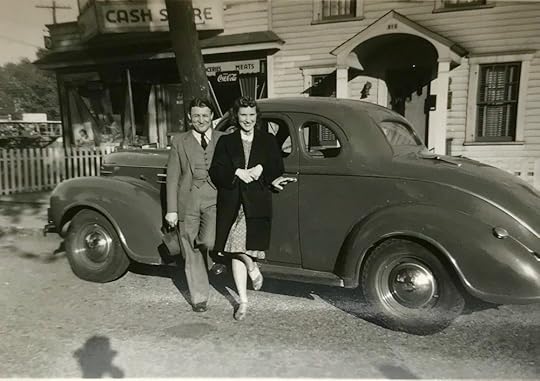
Newlyweds Ray and Ann, 1941
Over the weekend, they must have figured out a date for the wedding: mid-June. The countdown begins!
Grandpa has started to develop a plan to save for the date and afterward, when he'll be supported the two of them.
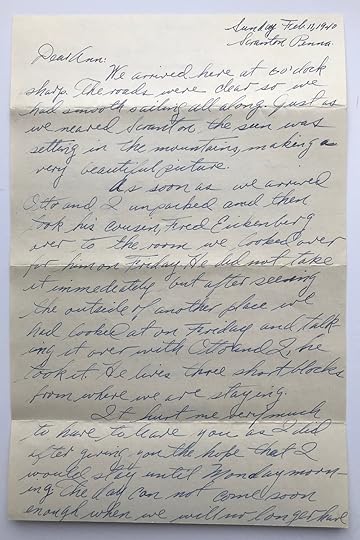
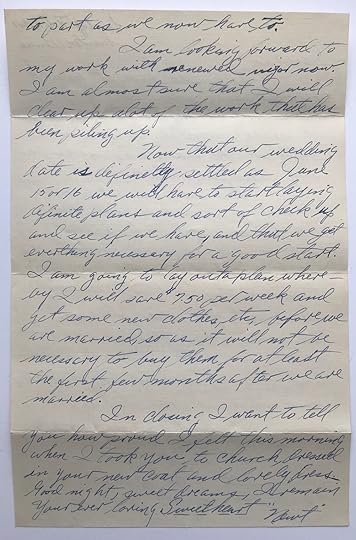
***
Sunday Feb 11, 1940
Scranton Penna.
Dear Ann:
We arrived here at 6 o'clock sharp. The roads were clear so we had smooth sailing all along. Just as we neared Scranton the sun was setting in the mountains, making a very beautiful picture.
As soon as we arrived Otto and I unpacked and then took his cousin, Fred Eickenberg over to the room we looked over for him on Friday. He did not take it immediately but after seeing the outside of another place we had looked at on Friday and talking it over with Otto and I, he took it. He lives three short blocks from where we are staying.
It hurt me very much to have to leave you as I did after giving you the hope that I would stay until Monday morning. The day can not come soon enough when we will no longer have to part as we now have to.
I am looking forward to my work with renewed vigor now. I am almost sure that I will clear up alot of the work that has been piling up
Now that our wedding date is definitely settled as June 15 or 16 we will have to start laying definite plans and sort of check up and see if we have and that we get everything necessary for a good start. I am going to lay out a plan whereby I will save $7.50 per week and get some new clothes, etc., before we are married, so as it will not be necessary to buy them for at least the first few months after we are married.
In closing, I want to tell you how proud I felt this morning when I took you to church, dressed in your new coat and lovely dress. Good night, sweet dreams, I remain Your ever loving Sweetheart.
“Newt”
.***
To learn the preservation secrets used by libraries, archives, and museums to protect their priceless materials (that you can also use for your family heritage items), read my book:
Creating Family Archives: How to Preserve Your Papers and Photographs
By Margot Note
If you like archives, memory, and legacy as much as I do, you might consider signing up for my email list. Every few weeks I send out a newsletter with new articles and exclusive content for readers. It’s basically my way of keeping in touch with you and letting you know what’s going on. Your information is protected and I never spam.
Ready to get started creating your family archives? Here are some of my favorite products:
Follow me on Pinterest | Instagram | Twitter | LinkedIn | Facebook
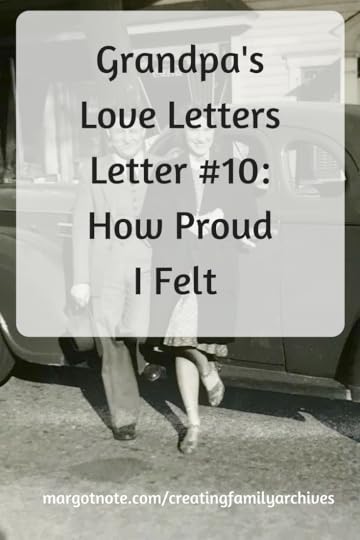
February 7, 2018
Letter #9: The Fondest Expectation
I'm continuing my series of scanning, transcribing, and annotating my grandfather's love letters to my grandmother leading up to their marriage in June 1940. The letters are chronologically organized and preserved, using the methods I discuss in detail in my book, Creating Family Archives: How to Preserve Your Papers and Photographs.
In the ninth letter in the series, Grandpa apologizes for not visiting the weekend before, and believes that he'll be able to come home for the weekend if his cold clears up.
He mentions that my grandmother wrote about having a fight with "Mr. Z." He's most likely referring to her stepfather, Mr. Zabit, or "Pop Zabit" as she wrote on this undated photograph.
[image error]
My grandmother wrote on the back of this photograph, "Pop Zabit, Ann + Ray Note."
This is the part of the series that I feel awkward about revealing online. Everyone involved is no longer alive, but I feel protective of my grandmother and revealing the difficulties of her life.
From what I understand, she had a hard life and grew up poor. When she was a little girl, her brother ate poison berries and died. Her grieving father drank rat poison soon afterwards and killed himself.
Her mother remarried, and her stepfather wasn't a nice man. He beat her mother (with either razor wire or a "razor whip;" I don't remember which but I was horrified when she told me as a kid). We also suspect he was abusive in other ways. I never heard good things about him from her, and I imagine he was a nightmare to live with.
The photograph above is difficult to look at because the body language is so tense. It looks like a police lineup instead of a family photograph.
What I loved about my grandmother is that despite her hard life, she had a wacky sense of humor. She would teach us swear words and silly songs in Lithuanian.
One time when I was visiting her as a kid, I started crying after she yelled at me, which she never did. She got a little cup and said, "Why don't you count your tears as you catch them." Of course, I was concentrating so hard on catching my tears, I forgot about what I was crying about. What a perfect way to distract a child!
When I visited her while she had Alzheimer's, she thought me and my husband were her children, and we still had a lot of fun during the visits even though she got confused about the details. The love was still there.
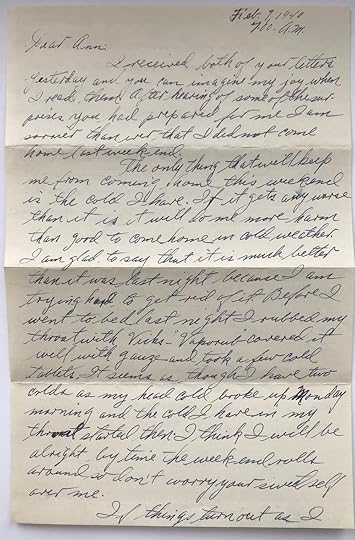

***
Feb. 7, 1940
7.00. A.M.
Dear Ann:
I received both of your letters yesterday and you can imagine my joy when I read them. After hearing of some of the surprises you had prepared for me I am sorrier than ever that I did not come home last week-end.
The only thing that will keep me from coming come this weekend is the cold I have. If it gets any worse than it is it will do me more harm than good to come home in cold weather. I am glad to say that it is much better than it was last night because I am trying hard to get rid of it. Before I went to bed last night I rubbed my throat with Vicks - "Vaporub" - covered it well with gauze and took a few cold tablets. It seems as though I have two colds as my head cold broke up Monday morning and the cold I have in my throat started then. I think I will be alright by [the] time the week-end rolls around so don't worry your sweet self over me.
If things turn out as I expect them to we should arrive in Paterson at about noon-time Saturday. Keep your fingers crossed and hope for some of the nice spring days. You mentioned in one of your letters because if the weather is decent Otto said we may not return until Monday morning. Say nothing of the above to Jean until it becomes definite because I would not want to have Otto change his plans. Let's hope we can spend two nights to-gether because I surely can stand it.
I had to interrupt this letter to take my turn in the bathroom, it is now 7.50 so I must get dressed for work
Glad you hear you are feeling well, but I am sorry to hear you had a quarrel with Mr. Z.
With the fondest expectation of spending a few hours with you again, I remain,
Your Sweetheart
"Newt"
P.S. I love you more than ever.
.***
To learn the preservation secrets used by libraries, archives, and museums to protect their priceless materials (that you can also use for your family heritage items) read my book:
Creating Family Archives: How to Preserve Your Papers and Photographs
By Margot Note
If you like archives, memory, and legacy as much as I do, you might consider signing up for my email list. Every few weeks I send out a newsletter with new articles and exclusive content for readers. It’s basically my way of keeping in touch with you and letting you know what’s going on. Your information is protected and I never spam.
Ready to get started creating your family archives? Here are some of my favorite products:
Follow me on Pinterest | Instagram | Twitter | LinkedIn | Facebook
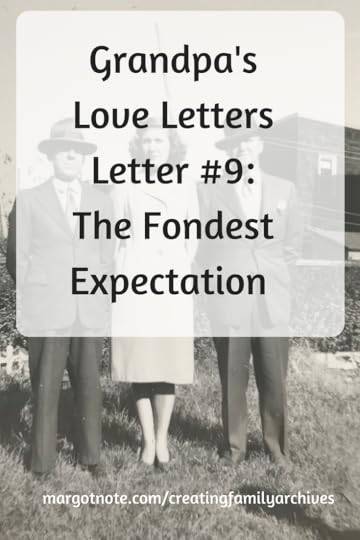
February 5, 2018
Writing for Career Success
The best thing you can do for your career is to write. Whatever your profession, there are opportunities to share your experiences, offer tips and tricks, and promote yourself through words. Writing is also an excellent way to brand yourself online, especially if you are looking for a new job or changing careers.
I believe anyone—even those that think that they are “bad writers”—can write elegantly. You just need to set pen to paper
I began writing professionally by writing book reviews in my field (which I’ll explain in detail in a moment). In time, I was asked to join the editorial board of a journal and later invited to guest-edit an issue. About seven years ago, I was approached by a publisher to submit a book proposal that led to my first book, Managing Image Collections: A Practical Guide. Some of my graduate school papers became part of chapters in that book. Some time after that, I was asked to submit another book proposal to the same publisher. My second book, Project Management for Information Professionals, arose from my curiosity about how to work better on teams. At the time, I was working on two painful projects for my employer, and I knew there had to be a better way of doing things! My third book, Creating Family Archives: How to Preserve Your Papers and Photographs, is self-published through Amazon. I’m now in negotiations with a publisher for a revised and expanded second edition. I’ve also written review articles, peer-reviewed articles, chapters in books, posters, blog posts, and presentations.
Here are some tips I’ve learned from more than a decade of professional writing:
Start SmallWrite a review for a professional journal. Editors are always looking for reviewers, so reach out to journals that interest you. You’ll most likely be placed on a list of other reviewers, and the editor will occasionally send out a list of books they have for review that you can claim. As you get to know the editor, he or she can put aside books of a particular topic for you. You’ll have about a month or so to read the book, then write a 500-1500 word review. You’ll wind up reading something you should already be reading anyway, you’ll get a free book, and you’ll see your name in print and online.
Never Miss a DeadlineIf you agree to a deadline, don’t break it. If something unforeseen comes up, alert whoever is responsible as soon as possible if you think your piece will be delayed. Make people’s lives easier by adhering to deadlines, and build a reputation for quality, timely work.
Search Outside of Your WorkplaceI’m hesitant to suggest writing for your employer. Often, the writing doesn’t credit you and, if it does, it can be limited to how long it’s available online or in print. Writing for an employer is often undervalued. You’ll be expected to write more with little or no credit.
I remember going to an interview years ago for a database administrator position. The interviewer saw that I was an English major as an undergraduate and then suggested that I should be their newsletter editor too. That, along with several red flags, made me decline the second interview. It also opened my eyes to how good writing skills can often be taken for granted by companies.
It’s far wiser to write outside your employer’s realm to build your brand professionally. Lean into your career, not your job.
For instance, I wrote books, chapters, articles, and reviews while working for a past employer; when I got laid off, I left with a portfolio of my own work. Everything that I had written for them disappeared into the ether after I left.
Don’t Take Criticism PersonallyDuring the writing process, you will often work with another person—be it a book editor, proofreader, or journal editor. Most people are wise about offering suggested changes, as they know how it feels to be on the receiving end of critical comments too. I’m not precious about my words. I will never win a literary award, but I want to make sure that I am as clear as possible. If someone suggests a better way of phrasing my words, I take their suggestions.
Ignore the "Grammar Nazis"They always identify themselves that way, and they rant about Oxford commas too. What pretentious bores!
There’s a type of person who takes delight in pointing out other people’s mistakes. They often are your co-workers, which is another reason to avoid writing for your employer. I’ve worked with a number of these types. They delighted in pointing out a misused word. Interestingly enough, they never bothered to get anything published themselves. Grammar Nazis never do.
Discover Where Your Audiences LiveExperiment with where your writing will be received the best. A blog post like this lives on my website first. I’ll link it to my social media accounts—Facebook, Twitter, Instagram, Pinterest, LinkedIn, and some LinkedIn groups. I also import my blog posts on Medium. Different audiences exist on different platforms, and I want my message to reach everybody.
You might have a niche audience so a forum, listserv, newsletter, or other means of information distribution may work for you.
Edit, Edit, and Edit AgainYou can always improve your writing. Nothing written the first time is good or should be. Rewriting and editing improves your text every time. The difference between adequate writing and good writing is revising, so keep revising—then revise more.
I often read my writing out loud and make edits. I’ll print out a hard copy, and revise further. I use tools like Grammarly, the Hemmingway app, and the Expresso app to catch errors. I also use text-to-speech readers to listen for awkward phrasing. You can also look at sites like Fiverr to hire copyeditors and proofreaders like myself. I enjoy revising so much that I decided that I might as well make money while doing it!
Forget PerfectionismNo one is perfect so don’t expect your writing to be perfect too. Write good enough in clear language about something you are passionate about. It can be big or small, practical or theoretical. Just create something that you are proud of and share it with the world. You’ll be surprised how writing about an aspect of your profession can let you get to know people with similar interests. Your name will start getting known, and you'll find that new opportunities will start to come your way. Trust me on this!
Do you have suggestions on writing that you'd like to share? Comment below or email me at margot@margotnote.com.
Learn more about my books:
Follow me on Pinterest | Instagram | Twitter | LinkedIn | Facebook
February 4, 2018
Letter #8: Very Truly Yours
I'm continuing my series of scanning, transcribing, and annotating my grandfather's love letters to my grandmother leading up to their marriage in June 1940. The letters are chronologically organized and preserved, using the methods I discuss in detail in my book, Creating Family Archives: How to Preserve Your Papers and Photographs.
In the eighth letter in this series, Grandpa seems like he's making up for not coming home the previous weekend. It's the first four-page letter in the series, and he discusses what he did while he stayed in town.
With Otto, he visited Nay Aug Park and the Everhart Museum, which looked like this at the time:
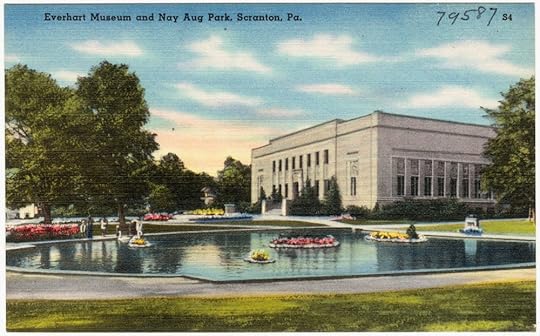
A 1940s postcard view of the museum and the park
Nay Aug Park is the largest park in Scranton, which features a gorge, a museum, pools and an amusement park. It also had a dancehall in the '30s and '40s and had once had a zoo. What was there when he visited?
The Everhart Museum of Natural History, Science & Art was founded in 1908. Its collections include zoological displays, Northeastern Pennsylvania art, ethnological artifacts, fossils, and American folk art. What exhibits did Grandpa and Otto view during their visit?
Grandpa also went to the same theater he mentioned in a previous letter. He saw the screwball comedy, His Girl Friday, which premiered in New York City the previous month.
[image error]
On the back of this photo, my grandmother wrote, "May 1935 Bear Mountain"
I've also been researching the specific work my grandfather did. I know that it was in a textile factory, and knowing that he had previously worked in Paterson, I'm assuming that it was in silk manufacturing.
Paterson, New Jersey has tremendous falls, and manufacturing came to the city to utilize this power. Mills manufactured many things over the years, but in the late 19th and early 20th centuries, so much silk was produced that Paterson became known as "Silk City." Two major strikes involving the silk industry in 1913 and 1935 brought Paterson to the national consciousness. I wonder if Grandma and Grandpa were involved in the last strike. One of the reasons that these strikes were unsuccessful was because of the competition of similar firms in Pennsylvania... most likely the mill that my grandfather was now working in.
I love labor history (a.k.a the people who brought you the weekend), so I will continue researching on this subject. For now, let's move on to his letter:
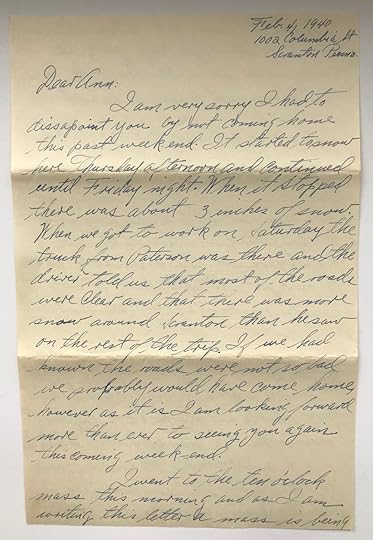
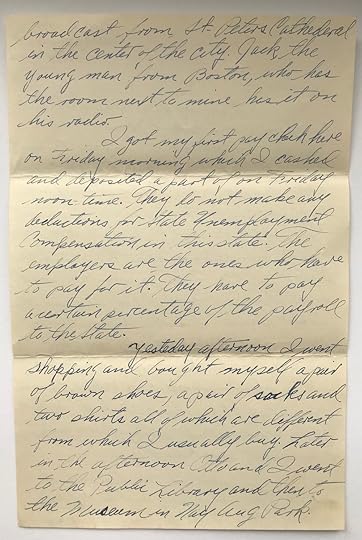
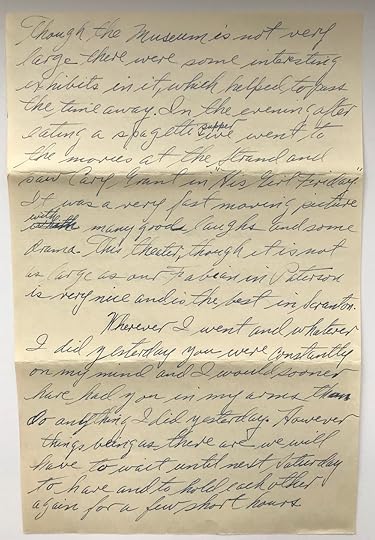
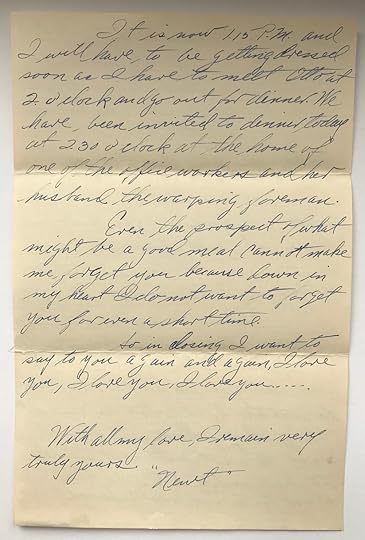
***
Feb. 4, 1940
1002 Columbia St.
Scranton Penna.
Dear Ann:
I am very sorry I had to dissapoint [sic] you by not coming home this past week-end. It started to snow here Thursday afternoon and continued until Friday night. When it stopped there was about 3 inches of snow. When we got to work on Saturday the truck from Paterson was there and the driver told us that most of the roads were clear and that there was more snow around Scranton than he saw on the rest of the trip. If we had known the roads were not so bad we probably would have come home, however as it is I am looking forward more than ever to seeing you again this coming week-end.
I went to the ten o'clock mass this morning and as I am writing this letter a mass is being broadcast from St. Peters Cathedral in the center of the city. Jack, the young man from Boston, who has the room next to mind, has it on his radio.
I got my first pay check here on Friday morning which I cashed and deposited a part of on Friday noon-time. They do not make any deductions for State Unemployment Compensation in this state. The employers are the ones who have to pay for it. They have to pay a certain percentage of the payroll to the State.
Yesteday [sic] afternoon I went shopping and bought myself a pair of brown shoes, a pair of socks and two shirts all of which are different from which I usually buy. Later in the afternoon Otto and I went to the Public Library and then to the Museum in Nay Aug Park.
Though the Museum is not very large there were some interesting exhibits in it, which helped to pass the time away. In the evening after eating a spaghetti supper we went to the movies at the Strand and saw Cary Grant in "His Girl Friday." It was a very fast moving picture with many good laughs and some drama. This theater though it is not as large as our Fabian in Paterson is very nice and is the best in Scranton.
Wherever I went and whatever I did yesterday you were constantly on my mind and I would sooner have had you in my arms than do anything I did yeserday. However things being as there [sic] are we we will have to wait until next Saturday to have and to hold each other again for a few short hours.
It is now 1.15 P.M. and I will have to be getting dressed soon as I have to meet Otto at 2 c'clock and go out for dinner. We have been invited to dinner today at 2.30 o'clock at the home of one of the office workers and her husband the warping foreman.
Even the prospect of what might be a good meal cannot make me forget you because down in my heart I do not want to forget you for even a short time.
So in closing I want to say to you again and again, I love you, I love you, I love you.....
With all my love, I remain very truly yours.
"Newt"
.***
To learn the preservation secrets used by libraries, archives, and museums to protect their priceless materials (that you can also use for your family heritage items) read my book:
Creating Family Archives: How to Preserve Your Papers and Photographs
By Margot Note
If you like archives, memory, and legacy as much as I do, you might consider signing up for my email list. Every few weeks I send out a newsletter with new articles and exclusive content for readers. It’s basically my way of keeping in touch with you and letting you know what’s going on. Your information is protected and I never spam.
Ready to get started creating your family archives? Here are some of my favorite products:
Follow me on Pinterest | Instagram | Twitter | LinkedIn | Facebook
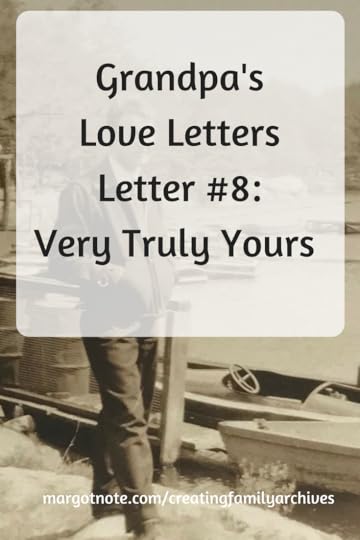
January 31, 2018
Letter #7: Your Ever Faithful Sweetheart
I'm continuing my series of scanning, transcribing, and annotating my grandfather's love letters to my grandmother leading up to their marriage in June 1940. The letters are chronologically organized and preserved, using the methods I discuss in detail in my book, Creating Family Archives: How to Preserve Your Papers and Photographs.
The seventh letter in this series raises many questions. Why is Otto's paycheck so secretive? Why is it coming from New York? Who was Charles (Grandpa's brother) visiting on Butter Street? What are the other things Grandpa will do once he gets home? Most importantly, will Ray and Otto come home for the weekend or not?!
I can't imagine what it would be like to work in one place and have your family in another, even if it's about two hours away like Scranton, Pennsylvania and Paterson, New Jersey is. It must get tiresome to come home every weekend, when you just want to relax from a week of work.
Here's a picture I found of my grandfather, my grandmother's step-brother, and an unknown friend. The friend doesn't look familiar, but I have to look more in my photo archives to see if there are other pictures of him. To me, he looks very Lithuanian so I wonder if it's a relative from my grandmother's side of the family. It's definitely not Otto, who is pictured in this post. Who is this man?
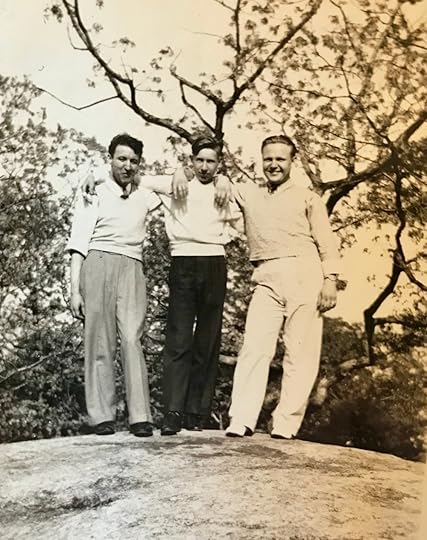
Ray, Joe, and unknown friend from (I'm assuming) the late 1930s
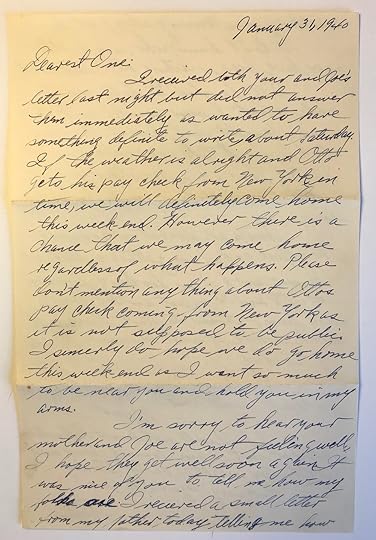

***
January 31, 1940
Dearest One:
I received both your and Joe's letter last night but did not answer them immediately as [I] wanted to have something definite to write about Saturday. If the weather is alright and Otto gets his pay check from New York in time, we will definitely come home this week-end. However there is a chance that we may come home regardless of what happens. Please don't mention anything about Otto's pay check coming from New York as it is not supposed to be public. I sincerely do hope we do go home this week-end as I want so much to be near you and hold you in my arms.
I'm sorry to hear your mother and Joe are not feeling well. I hope they get well soon again. It was nice of you to tell me how my folks are. I received a small letter from my father today telling me how everything was coming along at home.
I don't know who my brother may have been visiting on Butter Street.
I'll be glad to help you to decide about a new winter coat. There is a benefit fund here at the shop which I must talk over with you on Saturday. There are a few other things I would like to take care of when I come home.
Things are alright in general at the office and I am getting a little of the new work I am looking forward to. Otto and I expect another young man from Paterson to start here next week, perhaps it will be more definite by Saturday.
In closing I remain your ever faithful sweetheart.
Newt
P.S. I will not know definitely whether or not I am coming home until late Friday night or early Saturday.
Give my regards to Joe.
Ray
.***
To learn the preservation secrets used by libraries, archives, and museums to protect their priceless materials (that you can also use for your family heritage items) read my book:
Creating Family Archives: How to Preserve Your Papers and Photographs
By Margot Note
If you like archives, memory, and legacy as much as I do, you might consider signing up for my email list. Every few weeks I send out a newsletter with new articles and exclusive content for readers. It’s basically my way of keeping in touch with you and letting you know what’s going on. Your information is protected and I never spam.
Ready to get started creating your family archives? Here are some of my favorite products:
Follow me on Pinterest | Instagram | Twitter | LinkedIn | Facebook
